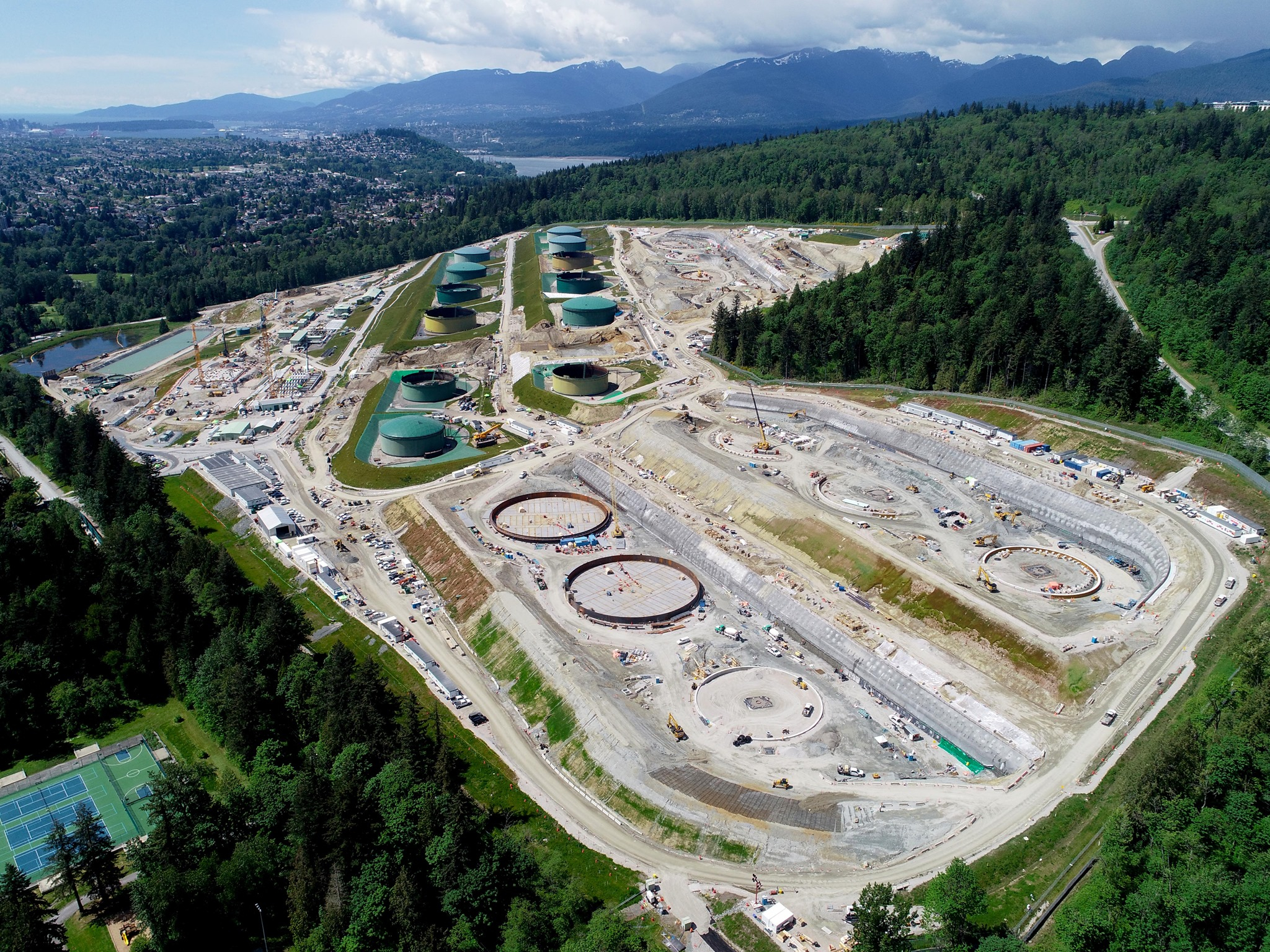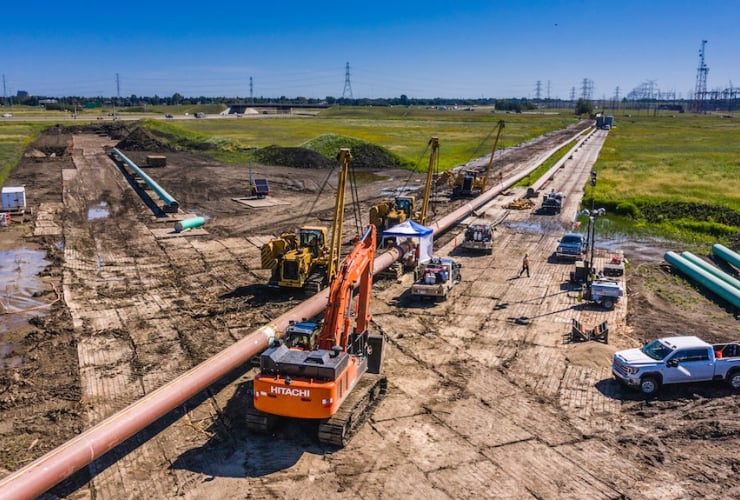Burnaby is fighting back against Trans Mountain’s request to be excused from certain fire safety plans.
In early December, the Crown corporation that is building a pipeline from Edmonton to a Burnaby terminal filed a request to the Canada Energy Regulator asking for a “constitutional declaration” that would allow it to build without having secured proper fire safety permits from the city. Since then, the city has mounted a defence and last week filed sworn affidavits accusing Trans Mountain of dodging critically important fire safety requirements.
The central issue is how quickly could the fire department respond to a blaze at the facility. Right now, the Burnaby terminal has 13 storage tanks with capacity to hold 1.6 million barrels of oil. The expansion plans would see the number of storage tanks doubled.
Earlier this year during a surprise inspection of the site, a tank fire simulation was controlled within two and a half hours (the target range is four hours). But Burnaby Fire Chief Chris Bowcock said at the time he wasn’t satisfied, and wanted the department to be able to provide a strong response to a fire within 10 minutes otherwise nearby residents would be at risk.
In a sworn affidavit dated Dec. 22, Bowcock told the Canada Energy Regulator the “key issue is Trans Mountain’s non-compliance with the fire lane standards established by Burnaby’s Fire Services Bylaw at the terminals.”
Those standards would require access routes that are wide enough, capable of supporting heavy fire trucks, have turning radii large enough to accommodate a fire truck, and have signs clearly indicating these are fire lanes. The affidavit says these requirements are “mandatory” and “applied consistently.”
“As fire chief, I view these requirements as the basic minimum standard for commercial and industrial development projects. For developments with a higher level of fire risk, such as a storage site for hydrocarbons, I would prefer to see more robust fire access standards (wider fire lanes and turning radii),” Bowcock wrote.
Elsewhere in the affidavit, he explains that fire lanes are not just about accessing a site but are also about where firefighting equipment can be set up and where firefighters can be deployed.
“Without sufficient space within the fire lane for these purposes, in the case of a hydrocarbon release and/or fire event, firefighting personnel may be placed in closer proximity to flammable hydrocarbons, increasing risk of harm or loss of life,” he wrote.
“As a fire chief with extensive experience in the context of planning hydrocarbon storage facility firefighting response procedures and pre-plan development, it is my view that there are multiple potential tank fire scenarios within the terminals that would be unextinguishable due to lack of safe firefighting positions.
“With these existing risks in mind, it is very concerning to me that Trans Mountain would be seeking confirmation of fire lane access plans on the basis of a lower standard than the mandatory minimum contained in Burnaby’s Fire Services Bylaw,” he wrote.
In documents filed with the regulator, Trans Mountain says Burnaby is being “unreasonable” by not issuing its building permits.
The Crown corporation says it has “sought to satisfy” Burnaby by providing a fire truck access plan, and amending it “repeatedly,” but “some of Burnaby’s requests cannot be implemented at the (Westridge Marine Terminal) and Burnaby Terminal due to site constraints, including grading and pipe location.”
Trans Mountain told Canada’s National Observer it has fire safety plans, including early fire detection and fire suppression systems and training exercises, but did not answer questions relating to fire lanes or how the delayed permitting is affecting its construction schedule.
In its application to the regulator, Trans Mountain stresses the urgency of its request is related to the construction schedule, which is long-delayed and pushing the cost of the project ever higher.
“Further permitting delays for the terminal work will imperil the project construction schedule,” Trans Mountain’s application reads, adding that if it isn’t given relief by Jan. 17, it will not be able to finish the project by its planned in-service date of December 2022.
In an affidavit from last year, Trans Mountain CEO Ian Anderson said each month the company is delayed from bringing the pipeline into service represents about $100 million in lost revenue. He also said construction delays of “several months” would result in “hundreds of millions in excess capital costs.”
On Dec. 23, on behalf of Burnaby, Ratcliff LLP senior counsel Gregory McDade responded to Trans Mountain’s request to sidestep fire safety requirements to say the city recognizes Trans Mountain’s terminals have federal approval, and the city cannot reject permits if it would be impossible for TMX to comply, but said this “constitutional issue does not arise here,” calling the fire safety bylaws “reasonable” and “constitutionally valid.”
“It is Trans Mountain’s failure to follow the Fire Services Bylaw and Building Bylaw that has prevented the issuance of permits, and it is Trans Mountain resistance to following these city obligations that has led to any time delays,” he wrote.
He further noted the CER is not a municipal regulator, and it “should be cautious” about overruling the very department that would have to respond to any emergency. McDade also wrote Trans Mountain has not provided evidence it would be impossible to meet the permitting requirements, and that before the commission accepts such a claim, it should be subjected to detailed scrutiny.
“The standard on constitutional matters is high, and mere added expense or inconvenience is not sufficient,” he wrote.
Megaprojects like TMX are susceptible to cost overruns because slight problems can cascade into larger delays given there are many moving pieces that have to happen in a certain order.
A report published in September by West Coast Environmental Law estimated the cost of TMX is approaching $20 billion, far higher than the price tag of $12.6 billion announced in February 2020. That report also details how the costs have grown substantially from the $5.4 billion first estimated by Kinder Morgan in 2013.
John Woodside / Local Journalism Initiative / Canada's National Observer
Take a good look at the photo
Take a good look at the photo and imagine all of those tanks ablaze. There are historic photos available showing just such incidents at other terminals. I cannot accept that any "simulation" could actually provide a reliable demonstration of the destruction and loss of life that could possibly occur if the whole place went up in oily smoke and flames. I would have thought that the primary concerns of TMX would have demonstrated a need to act more on the side of caution than prioritizing profit making. How is the entire project including pipeline and pumping stations considered as far as safety concerns are involved? We are inviting disaster for the sake of nothing other than corporate profit making at the expense of proper safety measures being put in place. Oh! What's new?
Nothing is new! Same old,
Nothing is new! Same old, same old, predatory capitalist slithering maneuvers to "out-smart" the entirely dispensable plebes and proles who stand in the way of "PROGRESS" (and profits). Our of concern for our lives, health, our community and environment can be wiped out by a "constitutional whatsit"?
Re the Planned in-service
Re the Planned in-service date of December 2022. Trans Mountain knows perfectly well this is a pipe dream and loses respect whenever it mentions it. For example the tunnel through Burnaby Mountain is well behind schedule; in the past three months it has progressed at 100 metres per month; it has 2100 metres to go; at this rate it will take another 21 months. After that the pipes have to be installed and pressure tested, and then there is the cathodic protection and backfilling to be done. It is unlikely to be finished before 2024.
The report by West Coast Environmental Law documents more delays.
I am grateful to the fire
I am grateful to the fire department in Burnaby for advocating for the safety of the residents.
“…Trans Mountain says Burnaby
“…Trans Mountain says Burnaby is being “unreasonable” by not issuing its building permits.”
Complete and utter bullshit.
The city of Burnaby has complied with the letter of its own bylaws and public safety criteria for several years now with respect to TMX permits, right from the first application. This, despite council’s deep and continuous philosophical and very public opposition to the project. It was TM that did everything in their power to NOT follow building permit requirements, to go behind the backs of Burnaby staff while sitting in meetings with smiles on their faces pretending to comply, and to cancel the requirement to apply for them in the first place.
They were dutifully awarded just that by the old National Energy Board that, by a twisted set of upside-down principles, gave three oil company hacks judicial powers over the public good. Now, a new application with the new Canadian Energy Centre (still seems to be a bunch of fossil lovers) to squash the Burnaby Fire Department’s extremely legitimate concerns about hopelessly inadequate safety standards at TM’s tank farm terminus. And under the guise of the Constitution too! How on Earth is the mandate to protect the lives and well being of 262,000 human beings who live in Burnaby deemed “unreasonable”?
TM was quickly bought by the feds under Trudeau’s hypocritical two-faced tutelage during a purely adolescent kneejerk reaction to a well-played strategic threat by Texas-based Kinder Morgan to kill the project, based on legitimate Indigenous opposition and violations of their constitutional rights.
By mere dint of federal ownership, TM has the constitutional right to practically build anything anywhere, and to cross any boundary anywhere in Canada. That right was confirmed by the Supreme Court of Canada in its very hasty decision to quash BC’s challenge to TMX based solely on the mere fact of ownership of the asset, while it ignored all other explicit concerns listed in BC’s court documents.
We need to remember this court-tested federal hegemony when it comes time to build things like a national smart grid for clean electricity over Alberta’s guaranteed hydrocarbon-based objections and legal challenges.
Trudeau has a year to compose and consult on the fed’s freshly announced climate “adaptation plan.” This is the time for him to alter his actions to match his pompous rhetoric, to build his legacy on the climate file, to set the nation on a new course.
But plowing ahead with another shameless move through the Constitution to actually put the lives of possibly a hundred thousand Canadians at risk is the very definition of a terrible beginning and a horrible way to start the New Year. Burnaby has every right to use its extensive financial resources to fight back.
“City of Burnaby Comments on
“City of Burnaby Comments on Trans Mountain’s Response to the National Energy Board’s Information Requests Nos. 1, 2, and 3 on the Burnaby Terminal Variance”
https://docs2.cer-rec.gc.ca/ll-eng/llisapi.dll/fetch/2000/90464/90552/54...
On page 5 of the above document is a graphic that illustrates the potential 5.2 km radius spread of deadly hydrogen sulfide gas in the smoke plume of a potentially large-scale hydrocarbon fire at the Burnaby Mountain Trans Mountain tank farm. The area extends deep into south and west Burnaby, and covers a ~5 km2 swath of Coquitlam, the SFU campus, and across Burrard Inlet to the North Shore to cover parts of Port Moody, Belcarra, most of Deep Cove and about half of the Tsleil Waututh Nation land. The total population of the covered area would be in the range of 100,000 people.
This location, chosen in the late 1950s when Burnaby was a small town and suburb of Vancouver separated by farmland and forests, would be the equivalent of placing a large oil tank storage farm on Signal Hill overlooking the vast residential areas of west Calgary.
Likewise, the Calgary equivalent to a Trans Mountain Afrimax tanker ship traversing Vancouver Harbour in front of the downtown towers would be a fleet of barges together carrying 550,000 tonnes of diluted bitumen pulled by tugboats on the Bow River, right past the downtown towers. Double-hulled, tug-tethered or not, would Calgarians even contemplate this ‘concept of equivalency’ in the first place? Even over their own Fire Department’s objections to the tank farm? Or the fleet of barges (one fleet on the river for every tanker on the BC coast) travelling 248 km downriver? That the same distance as every tanker must travel from Burnaby’s Westshore terminal to the open Pacific, most of it through a contorted marine route surrounded by 3.3 million people and irreplaceable marine ecological systems and habitat?
The above link also discusses the concerns over earthquakes (the pipeline route itself from the tank farm to the north side of Burnaby Mountain and the saltwater terminus on the inlet below is geotechnically unstable), the hopelessly inadequate risk assessment process, and much more.
Then there is the lack of proof that the project is economically viable given: that Asian refineries are not interested in paying a premium price (despite the proponent’s claims) on top of transoceanic shipping costs; that 1/3 of each barrel by volume shipped through the pipe is condensate with an attached sunk cost, not salable oil; and the poor quality of raw bitumen which necessitates additional steps in refining just to get it up to a usable crude feedstock.
None of this passes the sniff test, let alone 21st Century environmental and public safety standards or economic principles that account for climate change.
Correction: Canadian Energy
Correction: Canadian Energy Regulator (CER). Not to be confused with Alberta's Canadian Energy Centre, otherwise known as Jason Kenney's War Room.
On behalf of my grandchildren
On behalf of my grandchildren and their parents, who live in a neighbourhood and attend a school that is within 200 m of the tank farm, I thank the City of Burnaby for ensuring that TMX meets fire and safety regulations. How can TMX even think about compromising the safety of 100 000 people and push for arbitrary completion dates. I will be writing to the City of Burnaby and to TMX on this issue.







Comments